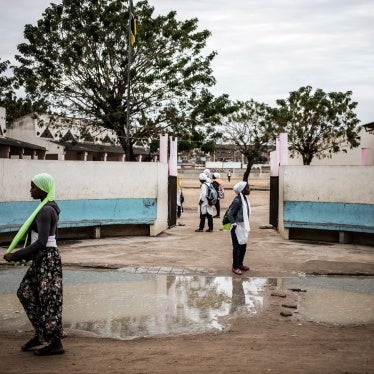As told by Meghan Rhoad, women's rights researcher
Nasra, a petite Somali woman wearing a navy blue hijab and long skirt, rocked her sleeping baby in her arms as she told me the story of how, two and a half weeks earlier, she had arrived here at Dadaab - the world's largest refugee camp - without her shoes.
She told me that only 12 days after giving birth to her daughter, she and her family fled their home in Dobley, Somalia, where rival Islamist groups had been clashing violently for months. "People were slaughtered, houses were burned," she said. "I feared for my life and the life of my newborn child."
They joined a group fleeing on foot through the bush and then over the nearby Kenyan border, toward Dadaab. After they crossed the border, some Kenyan police officers came upon them, she said, firing their guns into the air. The other Somalis ran away, but Nasra, carrying her baby, could not keep up and three policemen cornered her.
Dadaab was founded nearly two decades ago as Kenya began taking in refugees from Somalia's civil war and state collapse. Well over half a million Somalis now live as refugees in neighboring countries; 1.5 million are internally displaced, having fled their homes but staying in Somalia. It was hard for me to consider Dadaab a place of refuge, though, as I continued to collect the stories of women who were assaulted by police, or whom police had failed to protect from rape in the camps.
Nasra glanced at her baby as she continued her story.
One of the policemen began kicking her, she said. She pled for mercy, but he continued kicking her until she dropped her baby, and they forced her to the ground. There, with her baby only arms' length away, the officer raped her, and then stood guard while another officer did the same.
After the police left, Nasra picked up her baby and ran after her husband and three other children. She lost her shoes in the attack, and continued her day-long journey barefoot.
I met Nasra during my second week at Dadaab, where I was gathering research for a report on refugee abuses with my colleagues, Agnes Odhiambo, of the women's rights division and Gerry Simpson of our refugee policy program. Nasra stood out among the dozens of women who agreed to tell me their stories because of her composure, her resolve. It was sweltering outside, and the room we sat in, constructed from corrugated metal, mud and twigs, seemed to magnify the heat. But neither the heat, nor the terrible details of her story, affected her calm demeanor. She left me in awe.
Originally designed to accommodate 90,000 people, the Dadaab camps are now home to almost 300,000. Some refugees live in huts, some in tents, and some live in shelters made from sticks and tarps. Children constantly play underfoot, and puddles the size of ponds form after it rains. It's so congested that new arrivals no longer get a place to live. Instead, they are given a food ration card and sent to see if they can find a relative in the camps to take them in.
Before meeting Nasra, I had already interviewed more than two dozen women who had survived sexual violence, most of it within the camps.
Although most of these other women had not been assaulted by police, they directed much of their anger at the officers. "The police are not around to stop rape," one woman said. Indeed, the patrolling by police in the camp is minimal. Women told us over and over again that they had reported rape to the police but that there had been no effective investigation.
In 2009, the UN High Commissioner for Refugees and its partner agencies received 107 reports of sexual violence in the camps, but only 16 of the cases were prosecuted by the police. The number of unreported rapes is probably much higher.
In a congested environment like Dadaab, sexual assault and violence against women is always a major concern. First, there's the lack of physical security - there are few doors or lights here. Also, when more than one family lives in a tent or hut, violence against women increases.
Ultimately, we want the Kenyan government, along with aid agencies, to commit resources to the police. We want more police officers trained to handle sexual violence cases assigned to the camps, and we want more female officers. The police should capture suspected rapists and put them on trial. The police themselves need to be held accountable for their treatment of refugees in the camps and border areas.
In an encouraging sign, the Kenyan government has already responded to our report by establishing a committee to investigate sexual violence and the other abuses we documented.
Nasra made a point of speaking with me even though she had more pressing concerns - like finding shelter for her family before the next rain.
But we were there for the same reasons. She wanted her story heard, and her attack documented, and we both wanted change. Her baby girl needed a safe environment. Unlike most women I spoke with, Nasra didn't cry. But similar to most women, after she told me her story, she seemed somehow uplifted. Often, there's a feeling that they've done something, that their experience means something.
Yet I still had the feeling that Nasra's hardships were hardly over. How much support would she get in this situation? In part because of our work, we believe that in the future Dadaab can be a safer, more supportive place for Nasra, her baby daughter and the hundreds of thousands of other Somalis who take refuge there.


